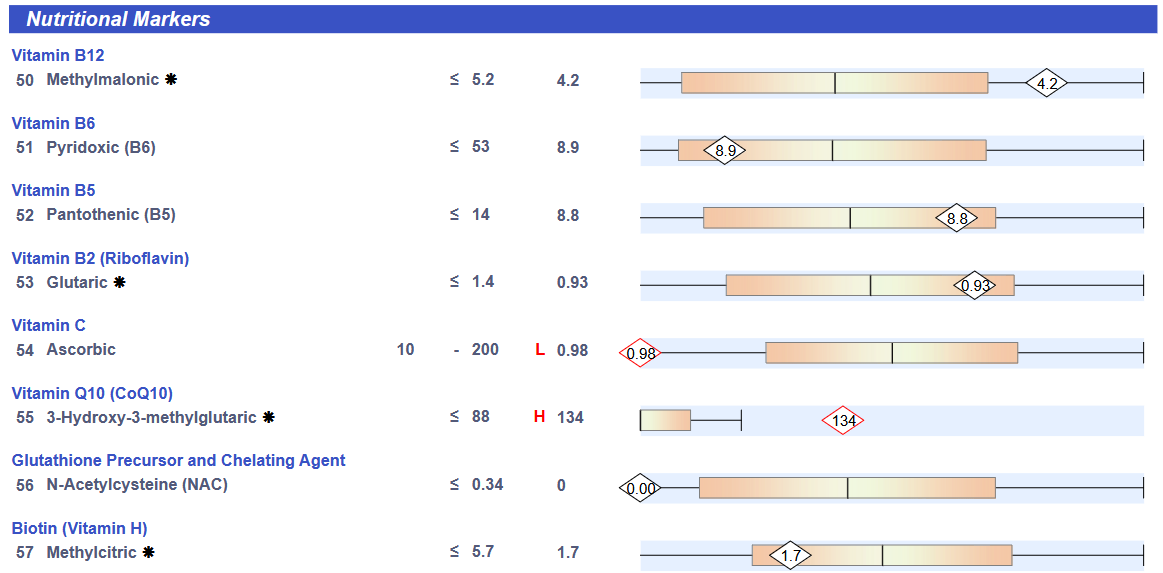Organic Acids Test from a Young Non-Verbal Child with Developmental Delay (Part 1)
A brief outline of various markers from an organic acids test (OAT) from Mosaic Diagnostics Laboratory
This organic acids test (OAT) profile, from Mosaic Diagnostics Laboratory, comes from a young child with an autism-diagnosis which includes poor eye contact, sensory system problems, developmental delay (poor milestone development), and constipation.
Page #1 - Yeast and Fungal Section
There are many elevated markers. The Arabinose (#7) is linked to digestive candidiasis, and carboxycitric (#8) indicates an overgrowth of digestive yeast which can include candida.
Markers #2, #4, #5, and #6 are linked to digestive colonization of aspergillus mold. This commonly occurs from environmental mold exposure such as the home which is the case in this situation. Tricarballylic (#9) is associated with fusarium mold exposure. This mold can be from water-damage in the home, as well as mold contaminated food such as grains, including corn and corn-products.
Page #1 - Bacterial Markers
All elevated markers on this test indicate digestive bacterial dysbiosis. The markers are not specific to one bacterial pathogen, but this pattern often occurs from microbiome disruption from environmental exposures (which can include mold) and chemicals.
Page #1 - Clostridia Bacterial Markers
The most common clostridia marker to see elevated is HPHPA. 4-cresol is another OAT marker indicating a Clostridium difficile (C. difficile) infection, and 4-hydroxyphenylacetic can also come from C. difficile. Having all three markers elevated is significant, but not common.
Page #3 - Oxalate Metabolites
Elevated oxalic acid indicates a high amount of oxalic acid being consumed from the diet, increased digestive oxalic acid absorption, or some metabolic problem that causes an accumulation of oxalic acid to be produced. There are certain genetic disorders where increased amount of oxalic acid occurs. Specific B-vitamin nutrient deficiences can contribute as well. In this case, the levels could also come from fungal production as both candida and aspergillus organisms produce oxalic acid in the digestive system.
Page #3 - Glycolytic Cycle Metabolites
The lactic is high normal, and the pyruvic is elevated. Both are linked to glycolysis and can occur elevated for various reasons. A common scenario is low conversion of pyruvic to acetyl-CoA because of nutrient deficits such as B-vitamins, including B1, B2, B3, and B5.
Page #3 - Mitochondrial Markers - Krebs Cycle Metabolites
Multiple markers elevated within the Krebs cycle indicates a mitochondrial dysfunction. The high succinic is linked to complex II of the electron transport chain through an enzyme succinic acid dehydrogenase. Fumaric, malic, and citric often appear elevated when there is high fungus, oxalic acid, and subsequent oxidative stress.
Page #3 - Mitochondrial Markers - Amino Acid Metabolites
Markers #30 and #32 are linked to amino acid leucine, and #31 to lysine. In this case, all values are normal.
Page #3 - Neurotransmitter Metabolites
The neurotransmitter section is one of the more complicated sections on the OAT biochemically to understand. Often in the presence of high clostridia markers (page #1), homovanillic (HVA) is elevated, along with DOPAC (#36). Vanillymandelic (VMA) can also appear low at the same time as high HVA. In this case, all values are in a normal range. The elevated kynurenic may be appearing elevated because of increased demand for energy production secondary to stress. This is usually seen with elevated quinolic acid.
Page #4 - Pyrimidine Metabolites
The folate metabolism markers are normal. High values are seen with folate deficiency or potential folate conversion problem scenarios.
Page #4 - Ketone and Fatty Acid Oxidation
All markers, except adipic, are elevated. There are many factors that can lead to elevated ketone and fatty acid oxidation markers. In many situations, this pattern is seen with mitochondrial problems, oxidative stress, and low L-carnitine levels. The high 3-hydroxybutyric and acetoacetic (both ketones) could be occuring from poor redox chemistry within the mitochondria. In some circumstances, the elevated ketones can be induced from a ketogenic or specific carbohydrate diets.
Page #4 - Nutritional Markers
There are multiple markers within the Nutritional Markers section of the OAT. In this case, marker #50 is high normal (indicating an increase need for B12), B6 is low normal, glutaric is high normal (indicating some need for B2), and vitamin C is low. The highly significant marker #56 indicates a CoQ10 deficiency which would compromise mitochondrial function.
Page #5 - Indicators of Detoxification
The main focus in this section are the elevated pyroglutamic and 2-hydroxybutyric acids indicating a glutathione deficiency. Elevated orotic and 2-hydroxyhippuric are seen with difficulty in processing ammonia, and digestive bacterial imbalance.
Page #5 - Amino Acid Metabolites
Marker #75 may indicate a problem in metabolizing succinic acid which compromises Kreb cycle activity. 3-methyl-2-oxovaleric elevation is seen with a thiamine (B1) deficiency. B1, along with many other B-vitamins such as B2, B3, and B5, are linked to mitochondrial activity. Therefore, in this case there are multiple markers on the OAT indicating a need for additional B-vitamins.
Page #5 - Mineral Metabolism
The phosphoric value is normal in this case.
This OAT example is especially complex because of so many elevated markers. In future Substack postings I will breakdown some of the individual components of this case and delve more deeply into various sections. Go to article 2 for updates.

















